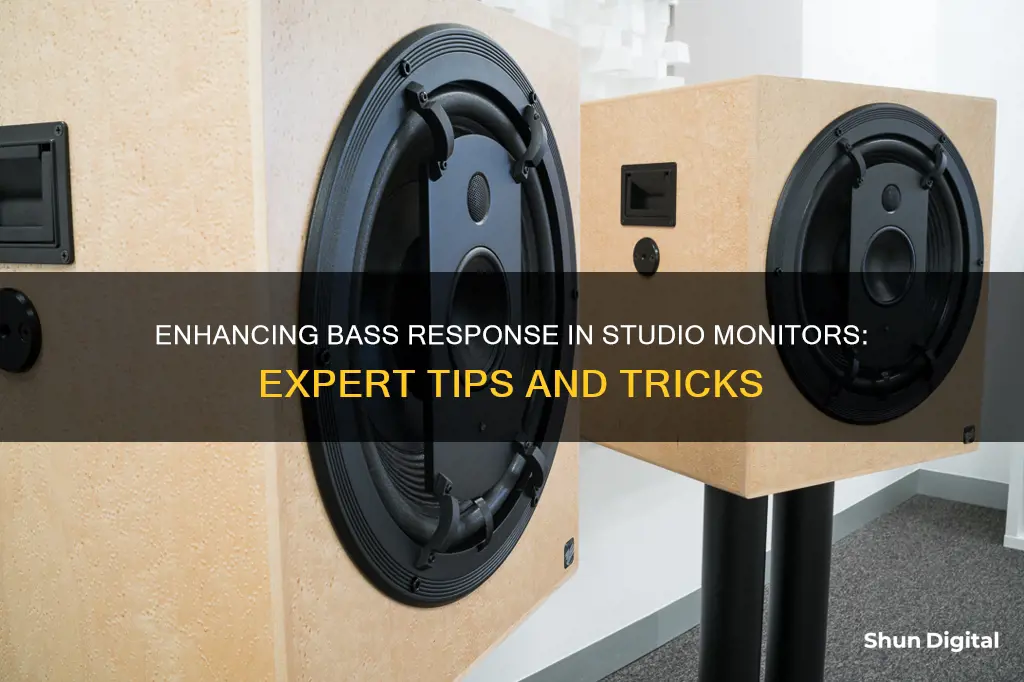
Improving the bass response of studio monitors can be achieved through a combination of equipment upgrades, room acoustics adjustments, and strategic speaker placement. One of the most common issues with bass response is standing waves, which can be mitigated by moving the listening position or using bass traps to prevent bass from bouncing off walls. Upgrading to larger studio monitors or adding a subwoofer can also enhance bass response, but proper placement is crucial to achieving the desired effect. Treating reflective walls with acoustic foam or other absorbent materials can help reduce unwanted reflections and improve bass definition. Additionally, utilising room treatment techniques, such as foam absorbers or acoustic tiles, can further enhance bass response by reducing early reflections and taming uneven bass response.
What You'll Learn
- Move your studio monitors or listening position to avoid standing waves
- Use bass traps to stop bass from bouncing around the room
- Use a larger room to reduce standing waves
- Place your subwoofer in the monitoring position, then crawl around the floor to find the best spot for it
- Use acoustic treatment to improve imaging

Move your studio monitors or listening position to avoid standing waves
Moving your studio monitors or listening position can be an effective way to avoid standing waves and improve bass response. When you change your position relative to the speakers, you may notice significant differences in the amount of bass you hear. This is due to the creation of standing waves in your room, where some spots have an abundance of a particular frequency, while others have almost none. As a result, even slight movements can cause you to pass through areas with drastically different sound characteristics.
To optimise your setup, consider experimenting with different placements of your studio monitors and listening position. Try moving your speakers or listening position around until you find a spot with the desired amount of bass. While this may not be a permanent solution, as it can create a small sweet spot and affect other frequencies, it can be a good temporary workaround.
In addition to repositioning your equipment, you can also try using bass traps. These devices help prevent bass from bouncing around the room and creating standing waves. By absorbing the low-frequency sound waves, bass traps can lead to a more even bass level and improve your overall listening experience.
Another option to consider is using a larger room. As the size of the room increases, the frequencies of standing waves decrease. By opting for a bigger space, you can effectively avoid standing waves in the audible frequency range, resulting in a more consistent and controlled listening environment.
It's worth noting that addressing standing waves can be a complex and challenging task. It may require a combination of different approaches, such as equipment repositioning, bass traps, and room size considerations, to find the best solution for your specific setup.
Hooking Your Predator Helios to a 144Hz Monitor
You may want to see also

Use bass traps to stop bass from bouncing around the room
Bass traps are an effective way to stop bass from bouncing around your room and creating standing waves. These standing waves cause inconsistencies in the bass response, with some spots in the room having almost no bass and others having a significant amount. Bass traps work by absorbing the bass, preventing it from reflecting off the walls and creating these problematic standing waves.
There are a few different types of bass traps available, each with its own advantages and disadvantages. One common type is acoustic foam bass traps, which are relatively inexpensive and easy to install. These bass traps are effective at absorbing high-frequency sounds but may be less effective at absorbing low-frequency bass. Another option is to use bass traps made from dense materials such as rock wool or acoustic panels. These traps are more effective at absorbing low-frequency bass but can be more expensive and may require professional installation.
When deploying bass traps, it is important to consider their placement. Corners and areas near the speakers are often good locations, as these are common spots for standing waves to occur. Additionally, covering a large surface area with bass traps can help improve their effectiveness.
In addition to bass traps, there are other techniques to reduce bass build-up in your room. One method is to use a larger room, as larger rooms have lower-frequency standing waves that are outside the audible range. Another approach is to adjust the placement of your speakers or listening position to find areas with better bass response. However, this may create other problems, such as a small "sweet spot" where the bass sounds good.
By using bass traps and considering the room's acoustics, you can significantly improve the bass response in your studio and create a more consistent and accurate listening environment.
Monitoring Data Usage: Vivo's In-Built Data Manager
You may want to see also

Use a larger room to reduce standing waves
When it comes to improving bass response in studio monitors, one of the most common issues is low-frequency irregularities in the room. This is caused by standing waves, which occur when low-frequency waves reflect and interfere with themselves, creating areas of reinforcement (antinodes) and cancellation (nodes) at different spots in the room.
To reduce standing waves and improve bass response, one solution is to use a larger room. In a larger room, the frequencies of standing waves are lower and often fall below the range of human hearing. This means that any irregularities in bass response caused by these waves become less noticeable or problematic.
The ideal room for reducing standing waves would have dimensions that evenly space out the modes, minimising the effects of reinforcement and cancellation. However, this approach requires careful planning and construction.
While using a larger room can help reduce standing waves, it is important to note that standing waves are a natural phenomenon and will occur to some extent in any room. Other methods for addressing standing waves include the use of bass traps, Helmholtz resonators, and membrane absorbers or panel traps. These solutions aim to reduce the amount of reflected low-frequency sound, creating a more accurate and consistent bass response.
In summary, using a larger room can be an effective strategy for reducing standing waves and improving bass response in studio monitors. However, it is important to consider the trade-offs in terms of cost, space, and the potential need for specialised construction or acoustic treatment.
Disabling HDR on Your ASUS Monitor: A Step-by-Step Guide
You may want to see also

Place your subwoofer in the monitoring position, then crawl around the floor to find the best spot for it
To improve the bass response in a studio monitor, one effective technique is to optimise the placement of the subwoofer. Start by placing the subwoofer in the monitoring position, then crawl around the floor near the walls to find the spot with the most balanced and even bass frequencies. Ideally, you should listen for a position on the wall behind and between the main speakers, as this has the least detrimental effect on stereo imaging.
When you move your head just a foot, you will notice significant changes in the bass energy. You will be surprised by how obvious the peaks and troughs in bass energy become as you shift your head. This process of physically moving around and listening for the best sound is crucial to finding the optimal position for your subwoofer.
In the case of Dave Wraight's studio setup, the Genelec 1091 subwoofer was initially placed underneath the desk in the centre of the front wall, which is not ideal for subwoofer placement. By crawling around the floor and listening for the most balanced bass, the Sound on Sound team determined that the best spot for the subwoofer was along the left wall, just in front of the desk. This new position provided a much broader and smoother contribution at the bottom end of the frequency range.
Additionally, it is worth noting that placing subs in the middle of walls is not recommended, as this is where a pressure minimum occurs, making it challenging for the subwoofer to function effectively.
Choosing the Right Monitor Size for Your VP Cabinet
You may want to see also

Use acoustic treatment to improve imaging
Acoustic treatment can help improve the imaging of your studio monitors by reducing reflections and improving the accuracy of the sound you hear. Here are some tips to enhance the imaging of your studio setup:
- Speaker Placement: Place your speakers symmetrically in the room, forming an equilateral triangle with your listening position. Avoid placing speakers too close to walls or corners as this can cause complex reflections and increase bass response unevenly. Ensure that the speaker-to-side-wall and speaker-to-front-wall distances are different, and avoid positioning speakers midway between the floor and ceiling.
- Speaker Orientation: Use your speakers in their intended orientation. Avoid laying them on their sides as it can compromise the stereo image and frequency response. Angle the speakers so that the tweeters are pointed directly at your head.
- Absorption Panels: Use absorption panels, such as acoustic foam or mineral wool, to treat high-frequency reflections. Place panels on walls, especially at reflection points, and on the ceiling. This will help reduce flutter echoes and improve imaging.
- Bass Traps: Use bass traps, such as rockwool or acoustic foam panels, to reduce standing waves and even out the bass response in the room. Place bass traps in corners and along walls to absorb low-frequency energy.
- Speaker Isolation: Ensure your speakers are securely mounted to reduce unwanted movement. Use speaker stands or spikes, especially on carpeted floors. This will prevent the speakers from vibrating and improve bass definition.
- Room Construction: Consider the construction of your room. Non-parallel walls can help reduce standing waves. Double-tacking, or adding an extra layer of plasterboard to walls, can also improve bass response and reduce sound leakage.
- Symmetry: Aim for symmetry in your setup, especially around your listening position. Symmetry helps create a balanced stereo image.
- Experimentation: Move your speakers and listening position to find the optimal arrangement. Small adjustments can make a significant difference in bass response.
Are My Text Messages Being Monitored? Signs to Look For
You may want to see also
Frequently asked questions
There are several ways to improve bass response in a studio monitor. Firstly, ensure that the studio monitor is not placed in the centre of a wall, as this can affect its ability to produce bass effectively. Adjusting the angle of the speakers so that they face the listening position directly can also improve bass response. Additionally, using bass traps or acoustic foam can help to reduce standing waves and improve bass response.
The placement of the studio monitor can significantly impact bass response. Moving the listening position or the studio monitor slightly can result in hearing significantly more or less bass. The size of the room also matters, with larger rooms typically providing a smoother bass response due to lower frequencies of standing waves.
It is recommended to test the studio monitor with familiar music or commercial CDs to identify any problems with the bass response. Additionally, specialised audio measuring systems, such as MLSSA (Maximum Length Sequence Spectral Analysis), can be used to obtain an objective frequency response plot and identify any irregularities.







